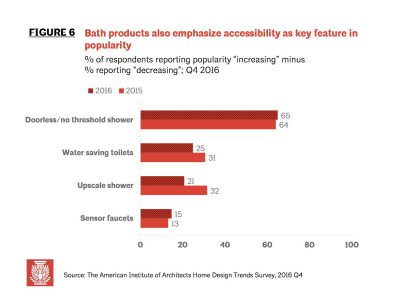According to the United Nations Population Fund, one in eight people in the world is age 60 or older—and the number is steadily growing. The significance of this overall aging of the population is reflected in bathroom remodeling trends reported by the AIA’s Home Trends Survey for the fourth quarter of 2016. Based on responses from more than 500 residential architecture firms, the survey indicates that accessibility is the primary concern when it comes to remodeling bathrooms. Thinking about their future needs, homeowners are choosing to spend money on making their bathrooms more accessible and easier to use.
Design for aging-in-place considers the importance of maintaining personal independence within
the built environment, while addressing changing functional needs. Simple bathroom features like door-less or no threshold showers have become a design trend—not just an accommodation for the elderly and those with mobility difficulties to enter or exit the shower compartment without assistance.
In addition to making houses more usable for an older population, designing so that homeowners can stay in their homes as they age contributes to the longevity of a house. Given the increasing concern about sustainability and the Green movement in architecture, design professionals are now recognizing the value of incorporating accessibility features into design projects.


Leave A Comment